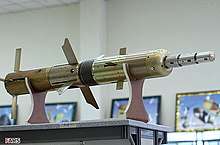Ground Forces of the Islamic Revolutionary Guard Corps
The Ground Forces of the Army of the Guardians of the Islamic Revolution (Persian: نیروی زمینی سپاه پاسداران انقلاب اسلامی), acronymed NEZSA (Persian: نزسا), are the land force which the Islamic Revolutionary Guard Corps (IRGC), maintain in parallel to the regular army of Iran. In addition to their conventional military role, the revolutionary guards' ground forces are more geared towards internal disorder than the regular army. However, in late years, the IRGC Ground Forces and by extension the entire IRGC, have transitioned to becoming an expeditionary force, capable of projecting power abroad, through conventional military operations or via proxies and unconventional warfare.[2] There are at least around 150,000 IRGC Ground Force troops.[3]
| Ground Forces of the Islamic Revolutionary Guard Corps | |
|---|---|
| Founded | Actual: 1980 Official: 17 September 1985 |
| Country | Iran |
| Branch | Land force |
| Size | ≈150,000 (2020)[1] |
| Part of | Islamic Revolutionary Guard Corps |
| Engagements | Iran–Iraq War Syrian Civil War |
| Commanders | |
| Current commander | Brig. Gen. Mohammad Pakpour |
| Insignia | |
| Flag | 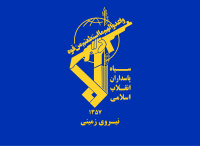 |
| Flag of armored units | 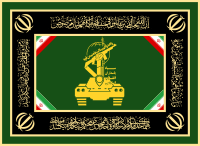 |
| Islamic Revolutionary Guard Corps |
|---|
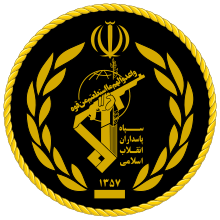 |
| Command |
|
Supreme Leader of Iran Commanders |
| Military branches |
|
Ground Forces Aerospace Force Navy Quds Force Basij |
| Intelligence agencies |
|
Intelligence Organization Intelligence Protection Organization |
| Personnel |
| Ranks insignia |
| Facilities |
|
Imam Hossein University Baqiyatallah University University of Command and Staff |
Following this transition, the Ground Forces structure remains focused on brigade levels units, supported by armoured, air support (drone), artillery, intelligence and special forces formations.[4]
History
The Army of the Guardians of the Islamic Revolution was officially established on 5 May 1979. It was conceived as a popular militia force to monitor the remainders of the Shah’s Artesh and defend the Islamic Revolution (such as against Nojeh coup plot).[5] However, the official establishment followed several months of activity of the Revolutionary Guards.[6]
According to Mohsen Rafiqdust, the establishment of and armed force tasked to secure the Revolution was proposed by Hujjat al-Islam Mohammad Montazeri, son of Ayatollah Hussein Ali Montazeri; Supreme Leader Ruhollah Khomeini ordered in February 1979 the establishment of such a force, which was established by Mohammad Montazeri itself and Ayatollah Mohammad Beheshti, leader of the Islamic Republican Party.[6] Moshen Rafiqdust was charged with organizing the Revolutionary Guard and Abbas Duzduzani was the first Commander.
Between February and December 1979, the IRGC evolved from a loose militia into an armed force;[6] In early days, IRGC units seemed to operate independently and in different capacities in different locations.[6] In March 1979, a national command was established.[6]
The mission of the Army of the Guardians of the Islamic Revolution accorded primacy to an internal security role, while at the same time pushing for the export of the Islamic Revolution:[5] in the early days, the IRGC was responsible for both internal and external intelligence and security, which was carried out in conjunction with the prime minister’s office; the alghare’eh, combat units, were involved in fighting enemy groups.[5][6]
Initially, the Army of the Guardians of the Islamic Revolution operated in coordination with Komitehs and their command echelon, but with an official approval.[6]
In the aftermath of the official establishment of the Army of the Guardians of the Islamic Revolution, there were four factions within it; these factions were included in the Command and Central Councils, with the greates influence exercised by the Mojahedin of the Islamic Revolution Organization.[6] Members of the Mojahedin of the Islamic Revolution Organization in the IRGC used their positions against the People's Mujahedin of Iran, Tudeh and Fadai in the general campaign against the political left and ethnic minorities, where the left was strong.[6] In September 1979, the IRGC were entrusted with providing security detail to Friday congregational prayer leader Ayatollah Montazeri, while failed to resist Iranian students in the seizure of the U.S. Embassy in Tehran.[6] The 1979 Iranian constitution gave Khomeini the supreme command of all armed forces, including the IRGC.[6]
In the wake of Iraq invasion of Iran in 1980, Islamic Republican Party (whose forces were led by the IRGC) and leftist organizations harshly confronted each other, resulting in thousands of casualties; the impeachment and removal of President Abolhassan Banisadr allowed the Islamic Republican Party to gain control of the defence strategy and to involve deeply the IRGC in it.[6]
The Iran-Iraq war caused the IRGC to align closely with the clerical rule of the Islamic Republican Party; IRGC commander Mohsen Rezai resigned from Mojahedin of the Islamic Revolution Organization due to the latter's contrast with the clerical rule.[6] During the confrontation between Montazeri and President Akbar Hashemi Rafsanjani, hundreds were arrested from IRGC ranks. By 1988, the radical-leftist faction had vanished within the IRGC.[6]
IRGC membership grew steadily in the first years of operation and during the Iran-Iraq War: by the end of 1979 there were about 10,000 guardsmen; in mid 1980 the number swelled to 25,000 and reached 50,000 by the end of 1981. In 1986 there were 350,000 guardsmen,[6] organized into battalion-level units.[7] The Iran-Iraq war forged the identities of the IRGC, Basij, and other associated organizations.[6]
After the war, the Iranian leadership provided the IRGC new outlets of service.[6] Some, external to the Basij, proposed their demobilization or their merger in the IRGC under the name of Resistance Guard.[8] Instead of demobilizing IRGC and Basij, Iranian leadership maintained and expanded their mobilization, particularly in extra-military sectors.[6]
In 1989, the IRGC lost its ministry and was merged with the Artesh in the Ministry of Defence and Armed Force Logistics as part of a Rafsanjani's policy aimed at reforming and consolidating the state control over governmental institutions. The IRGC even received a military ranks system.[6] Between 1990 and 1995 the Basij Resistance Force was supported by new Supreme Leader Ali Khamenei against the Ground Forces of the Army of the Guardians of the Islamic Revolution in equipment allocations. The Basij supplanted the IRGC also in guarding sensitive buildings and installations.[8]
However, Supreme Leader Khamanei managed to forge in the early 1990s a solid alliance with the Army of the Guardians of the Islamic Revolution; in the late 1990s, during the Mohammad Khatami's presidency, the IRGC provided the conservative faction considerable resources in the usage of force in combating perceived political threats.[6]
During the presidency of Mahmoud Ahmadinejad (2005–2013), the IRGC was increased its influence in Middle East (in Lebanon but especially with Shiite stakeholders in Iraq), but also in Chavez's Venezuela.[6] In 2009 Basij military responsibilities (including Basij military training) were transferred back to the Ground Forces of the Army of the Guardians of the Islamic Revolution in order to free the former and let it to concentrate on cultural struggle.[8]
The Islamic Republic of Iran has been involved in active support to Syria since early stages of the Syrian Civil War; while the initial instrument of support was the Qods Force, the IRGC Ground Forces subsequently stepped in.[3]
In 2017, Brigadier General Mohammad Pakpour, IRGC Ground Forces Commander, stated that the NESZA set up a drone centre.[9]
Commanders
- Mohammad Jafar Asadi (2008–2009)[10]
- Mohammad Papkour (2009–present)
Organization

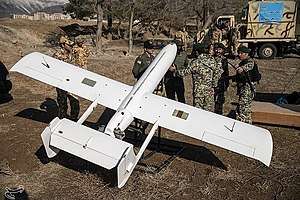
Across their 38 years-long history, the IRGC Ground Forces underwent to several organizational changes. From 2007 until 2015, they were organized in territorial commands in order to ensure defence against ground invasion and decapitation strikes, as well as to counter internal unrest. Alongside territorial commands, the IRGC Ground Forces also have conventional formations.[3]
The 2007–2015 structure included 32 separate commands: 32 Provincial commands and a Tehran city command;[3] IRGC territorial commanders have a direct supervision over local Basij organizations[8] and enjoy of authority and autonomy in order to be enabled to independently take action in case of an immediate crisis arising,[11] Provincial units are composed of the natives of the province in which the IRGC Ground Force members serve.[12]
According to Anthony Cordesman and Bryan Gold, the IRGC Ground Forces control the Basji and strictly cooperate with Basji's Imam Hossein Brigades.[4]
The IRGC also maintain a structure of infantry and armoured formations.[9] NEZSA also include artillery and engineer units and an airborne brigade. The IRGC Ground Forces have recently announced efforts to form an air assault unit.[3]
The IRGC Ground Forces have several elite units, the Saberin Unit. The Saberin Unit is a force highly trained in a number of specialized capabilities. Some IRGC divisions and brigades have separate Saberin units directly subordinated to them.[3] The IRGC has also designated certain formations as light infantry commandos, or takavaran.[3] In 2017 the NESZA set up a drone centre.[9]
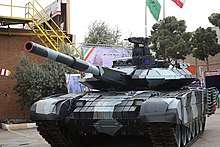
Due to the involvement of the IRGC Ground Forces in the Syrian Civil War,[3] according to Ali Alfoneh for Atlantic Council an increased deployment of IRGC Ground Forces in Syria changed the IRGC itself from a political army, tasked with countering domestic unrest, to an expeditionary force.[12]
See also
- Military of Iran
- Islamic Republic of Iran Army
- Iranian military industry
- Equipment of the Iranian Army
- Historical equipment of the Iranian Army
References
- The International Institute of Strategic Studies (IISS) (2020). "Middle East and North Africa". The Military Balance 2020. 120. Routledge. pp. 348–352. doi:10.1080/04597222.2020.1707968. ISBN 9780367466398.
- http://csis.org/files/media/csis/pubs/060728_gulf_iran.pdf
- Bucala, Paul; Kagan, Frederick W. (March 2016). "Iran's Evolving Way of War" (PDF). Critical Threats. pp. 10–11. Retrieved 17 June 2017.
- Cordesman, Anthony H.; Bryan, Gold; Garrett, Berntsen (2014). The Gulf Military Balance The Conventional and Asymmetric Dimensions. Lanham: Center for Strategic & International Studies. pp. 131–132, 143. ISBN 978-1-4422-2792-7. Retrieved 18 June 2017.
- Frederic Wehrey; Jerrold D. Green; Brian Nichiporuk; Alireza Nader; Lydia Hansell; Rasool Nafisi; S. R. Bohandy (2008). "The Rise of the Pasdaran Assessing the Domestic Roles of Iran's Islamic Revolutionary Guards Corps" (PDF). RAND Corporation. pp. 20–21, 30. Retrieved 19 June 2017.
- Afshon P. Ostovar (2009). "Guardians of the Islamic Revolution Ideology, Politics, and the Develo pment of Military Power in Iran (1979–2009)". University of Michigan. pp. 48, 51–53, 54–55, 59, 60–61, 66, 68–69, 73–74, 75, 85–86, 100, 108, 130, 157, 135–136, 132, 173–174. Retrieved 19 June 2017.
- Sloan, Stephen; Anderson, Sean K. (2009). Historical Dictionary of Terrorism. Plymouth: The Scarecrow Press. p. 318. Retrieved 20 June 2017.
- Golkar, Saeid (2015). Captive Society: The Basij Militia and Social Control in Iran. Washington D.C.: Columbia University Press. pp. 17–19, 27–28, 31. Retrieved 20 June 2017.
- "IRGC Ground Forces launch drone organization". PressTV. 26 February 2017. Retrieved 18 June 2017.
- "Report: Iran appoints new commander in Syria". Al Arabiya News. 29 December 2015. Retrieved 20 June 2017.
- Sinkaya, Bayram (2016). The Revolutionary Guards in Iranian Politics: Elites and Shifting Relations. New York: Routledge. p. 52. ISBN 978-1-138-85364-5.
- Alfoneh, Ali (4 April 2017). "Iran's Revolutionary Guards Transform into an Expeditionary Force". Atlantic Council. Retrieved 18 June 2017.
External links
![]()
